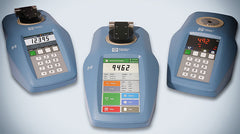This blog was originally posted on our sister site www.bellinghamandstanley.com and over the coming few weeks we will be syndicating the content for our readers at Refractometer Shop.
We think you'll find some useful tips, helpful reminders and practical advice for refractometer use whether you are the owner of a handheld refractometer, or user of a benchtop instrument.
Over 100 years refractometer experience
With over 100 years experience, Bellingham + Stanley are well positioned to give good, practical advice to refractometer users all around the world. We’ve pulled together 18 top tips for achieving quality results from your refractometer which we will be sharing with you over the next few weeks. Whether you’re looking for hints on buying the best refractometer for your application or wanting to learn about refractometer care and maintenance we’ll have something for you.
Refractometers 101: What is a refractometer and how does it work?
 A refractometer is a scientific instrument used to measure refractive index. As Xylem Analytics state: “When light passes from one medium to another, the speed at which the light travels will change depending on the parameters of the materials. This principle can be seen when looking at a straw in a glass or an oarsman on the river, where the straw or oar appears to be bent at the water/air interface. The ratio or change in the speed of light is called refractive index and instruments that measure this are called refractometers.”
A refractometer is a scientific instrument used to measure refractive index. As Xylem Analytics state: “When light passes from one medium to another, the speed at which the light travels will change depending on the parameters of the materials. This principle can be seen when looking at a straw in a glass or an oarsman on the river, where the straw or oar appears to be bent at the water/air interface. The ratio or change in the speed of light is called refractive index and instruments that measure this are called refractometers.”
Refractive index is often converted into a concentration measurement, typically of sugar (displayed commonly as °Brix) for food applications or other easily useable concentration scales relative to the products being measured. Common scales include °Brix, Ethylene Glycol, Propylene Glycol, Fructose, Glucose, Starch, Water-in-Honey, Urea, Wort, and °Zeiss.
Refractometers come in several shapes and sizes and differ in accuracy and technological sophistication. From simple optical handheld instrumentation, to digital bench-top refractometers with flow-through accessories that can form part of complete purity packages.
Before we get started with our top tips for achieving quality results from your refractometer we wanted to talk a little about quality control.
Refractometers For Quality Control
 Refractometers are commonly used as a quantity control tool within factories and laboratories. The importance of good quality control (often referred to as QC), whether in food, beverage, pharmaceutical or chemical manufacture, is to ensure all finished product is consistent and meets the required (and often regulated) specification.
Refractometers are commonly used as a quantity control tool within factories and laboratories. The importance of good quality control (often referred to as QC), whether in food, beverage, pharmaceutical or chemical manufacture, is to ensure all finished product is consistent and meets the required (and often regulated) specification.
Investing in a good quality refractometer from a reputable manufacturer, such as Bellingham + Stanley, is therefore essential to the quality of your end product – whether you’re making small batch craft beer, supplying a supermarket with jams and marmalades, or determining purity and concentration of pharmaceutical ingredients. Refractometers from Bellingham + Stanley are supplied with a unique serial number and Certificate of Calibration ensuring every instrument you buy may be traced to NIST and ICUMSA standards.
Good QC has an impact on profits too. Most people define QC as quality control but it can
also be interpreted as quantity control, where quantity relates to the dilution or blend of, say, an expensive raw material such as concentrated apple pulp used to make juice. Over-dilute and you’re simply giving money away. Under dilute and you run the risk of breaching specification limits, creating unhappy customers who don’t come back for more, or even losing supply contracts.
Next time, we’ll be starting our 18 top tips for achieving quality results from your refractometer with a focus on initial investment and preparation. In the meantime, if you’d like to learn more about Bellingham + Stanley refractometers visit their website for a refractometer overview or take a look at Refractometer Shop's collections today.
